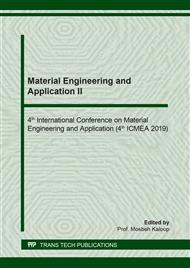[1]
C. Shen, L. Wang, Q. Li, Optimization of injection molding process parameters using combination of artificial neural network and genetic algorithm method, J. Mater. Pro. Tech. 183(2-3) (2007) 412-418.
DOI: 10.1016/j.jmatprotec.2006.10.036
Google Scholar
[2]
L. M. Galantucci, R. Spina, Evaluation of filling conditions of injection moulding by integrating numerical simulations and experimental tests, J. Mater. Pro. Tech. 141(2) (2003) 266-275.
DOI: 10.1016/s0924-0136(03)00276-0
Google Scholar
[3]
B. Ozcelik, T. Erzurumlu, Determination of effecting dimensional parameters on warpage of thin shell plastic parts using integrated response surface method and genetic algorithm, Int. Commu. Heat Mass Trans. 32(8) (2005) 1085-1094.
DOI: 10.1016/j.icheatmasstransfer.2004.10.032
Google Scholar
[4]
W.-C. Chen, P.-H. Tai, M.-W. Wang, W.-J. Deng, C.-T. Chen, A neural network-based approach for dynamic quality prediction in a plastic injection moulding process, Exp. Sys. App. 35(3) (2008) 843-849.
DOI: 10.1016/j.eswa.2007.07.037
Google Scholar
[5]
C. M. Seaman, A. A. Desrochers, G. F. List, Multiobjective optimization of a plastic injection moulding process, IEEE Trans. Cont. Sys. Tech. 2(3) (1994) 157-168.
DOI: 10.1109/87.317974
Google Scholar
[6]
M. A. Islam, H. R. Ong, B. Ethiraj, C. K. Cheng, M. M. R. Khan, Optimization of co-culture inoculated microbial fuel cell performance using response surface methodology, J. Environ. Manage. 225 (2018) 242-251.
DOI: 10.1016/j.jenvman.2018.08.002
Google Scholar
[7]
H. R. Ong, D. R. Prasad, M. R. Khan, D. S. Rao, J. Nitthiyah, D. K. Raman, Effect of jatropha seed oil meal and rubber seed oil meal as melamine urea formaldehyde adhesive extender on the bonding strength of plywood, J. Appl. Sci. 12(11) (2012) 1148-1153.
DOI: 10.3923/jas.2012.1148.1153
Google Scholar
[8]
H. R. Ong, D. M. R. Prasad, M. M. R. Khan, Optimization of preparation conditions for melamine urea formaldehyde based adhesive for plywood application using response surface methodology, Indian J. Chem. Technol. 23(1) (2016) 39-46.
Google Scholar
[9]
B. Ozcelik, T. Erzurumlu, Comparison of the warpage optimization in the plastic injection moulding using ANOVA, neural network model and genetic algorithm, J. Mater. Pro. Tech. 171(3) (2006) 437-445.
DOI: 10.1016/j.jmatprotec.2005.04.120
Google Scholar
[10]
T. Erzurumlu, B. Ozcelik, Minimization of warpage and sink index in injection-molded thermoplastic parts using Taguchi optimization method, Mater. Design 27 (2006) 853-861.
DOI: 10.1016/j.matdes.2005.03.017
Google Scholar
[11]
B. Farshi, S. Gheshmi, E. Miandoabchi, Optimization of injection molding process parameters using sequential simplex algorithm, Mater. Design 32 (2011) 414-423.
DOI: 10.1016/j.matdes.2010.06.043
Google Scholar


